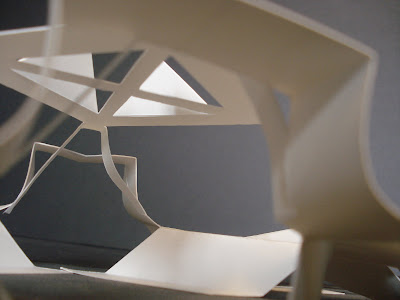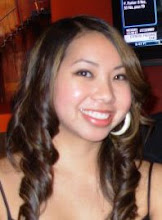skip to main |
skip to sidebar
CONCEPT
I decided to make a container for green apples and focused on its color, shape, size, and weight. The aspect of my container that involves all four focuses is the funnel. I specifically chose a metal funnel to enhance the color and to also hold an apple without bending or breaking. The shape of a funnel fits an apple well. Like the apple it has wider top and slimmer bottom. I chose the funnel size that would best fit an average sized green apple. The function of my container is to present the apples in a more creative way and to glorify the apple.  MATERIALS
MATERIALS
Along with metal funnels, metal skewers, wire, one rubber band, glue, and a wooden dowel were used to construct the container. The wire mainly held the container different materials together. The skewers were bent and glued to the funnel. The wire warped around the skewers and through a hole in the dowel. The rubber band was cut into pieces and glued at the bottom of the skewers to make the container more stable.

INSPIRATION
My clients favorite piece in her home was the center piece at her wedding. She loves the colors, and its organic, natural essence. She also cherishes the memories that come with the piece. It is a symbolization of happiness.
 CONCEPT MODEL
CONCEPT MODEL
While looking at the center piece words started to come to mind; organic, natural, tranquil, balanced, asymmetrical, oriental. I also looked at the picture as a whole and tried to piece together what kind of environment she was trying to accomplish in that space. I notice candles on a platform with pebbles and more candles surrounding the piece. With all these things in mind I thought of Zen; a state of mind where you become one with body and mind. When I researched Zen I also came across Feng Shui; harmony and positive energy in a space, translated it also means "the way of the water and wind."Since the symbol of Zen is a hand drawn circle, I wanted to use it in my concept model. So with that I created a tube and incorporated organic curves in the tube to represent water and wind. The chip board was left as is to express the integrity of materials and the earth toned natural brown. The concept model symbolizes being one with body and mind in meditation, and with that accomplishing inner harmony, positive energy, and peace.

 INTERIOR FINISHING
INTERIOR FINISHING
My client wanted an earthy tone color scheme, so I pulled colors from the center piece and used golds, creams, browns, and reds in the kitchen design. I also used a pattern for the window and door panes that was inspired by the wooden balls that were placed in the vase. The fabric samples may be used for curtains or the sliding doors separating the kitchen and dining room. The material for the sliding doors are transparent so even though the doors are closed light can still shine through. Sliding doors were used to separate the two rooms so that residents have an option of closing the door to hide the kitchen, or to leave it open to create a more open atmosphere and also see through the kitchen and out the window. Bamboo would be used for the flooring and the carpet samples are some ideas for the living room. The light fixtures were also based on the center piece, just like its vase it is cylinder.
 PLANOrganic curves were used to design the west kitchen wall, the island, and the reading area in the family room. Large windows were used to allow as much natural light as possible. The kitchen has efficient work triangle and through-traffic does not disturb or interrupt people cooking in the kitchen. There is sufficient work space and storage, and appliances that the client requested were added to the kitchen plan and design. The island has two different counter top levels the stove counter top is lower so that the vent can be installed under the high counter top.
PLANOrganic curves were used to design the west kitchen wall, the island, and the reading area in the family room. Large windows were used to allow as much natural light as possible. The kitchen has efficient work triangle and through-traffic does not disturb or interrupt people cooking in the kitchen. There is sufficient work space and storage, and appliances that the client requested were added to the kitchen plan and design. The island has two different counter top levels the stove counter top is lower so that the vent can be installed under the high counter top.
 CONCEPT The flowing orchids, cherry blossoms, and branches of the client’s wedding center piece cause ones eyes to follow the curves throughout the piece; leading you from one aspect to the next. This inspiration of the kitchen and family room design creates an emphasis on flow, circulation, nature, simplicity, and balance, which can be summed up as Zen. It is a place where people can become one with body and mind, away from life’s stresses, to obtain mindfulness, and spiritual refinement. The kitchen and family room will exude a sense of tranquility, energy, and flow with its organic shapes, much like the Zen symbol in its simplicity.
CONCEPT The flowing orchids, cherry blossoms, and branches of the client’s wedding center piece cause ones eyes to follow the curves throughout the piece; leading you from one aspect to the next. This inspiration of the kitchen and family room design creates an emphasis on flow, circulation, nature, simplicity, and balance, which can be summed up as Zen. It is a place where people can become one with body and mind, away from life’s stresses, to obtain mindfulness, and spiritual refinement. The kitchen and family room will exude a sense of tranquility, energy, and flow with its organic shapes, much like the Zen symbol in its simplicity. 
 After observing, analyzing, and actually taking part in experiencing the Waller Hall kitchen, we realized how important it is to consider the interaction between space, movement, and ourselves in design. It is this interaction that determines whether a kitchen is functional and efficient. Especially in a kitchen because people are constantly moving. As for our case study, the Waller Hall kitchen on the Washington State University campus, we have noticed both functional and non-functional, and efficient and inefficient aspects. The first aspect we noticed was how spacious it was. Since it is a kitchen at a dormitory, space was considered to accommodate its large number of student residents.Although the Waller Hall kitchen has sufficient space for multiple people and mass storage, the through-traffic to the adjacent rooms went through the work triangle in the kitchen. Since there was only one entrance to the kitchen the circulation was very inefficient and dangerous. Cabinet doors and the refrigerator door got in the way of the entrance and through traffic. Also to get to the microwave people would have to walk around the whole counter to the other side since it was facing the opposite direction of the kitchen and work area. The dining table was also in the same area so again people would have to walk around the counter.
After observing, analyzing, and actually taking part in experiencing the Waller Hall kitchen, we realized how important it is to consider the interaction between space, movement, and ourselves in design. It is this interaction that determines whether a kitchen is functional and efficient. Especially in a kitchen because people are constantly moving. As for our case study, the Waller Hall kitchen on the Washington State University campus, we have noticed both functional and non-functional, and efficient and inefficient aspects. The first aspect we noticed was how spacious it was. Since it is a kitchen at a dormitory, space was considered to accommodate its large number of student residents.Although the Waller Hall kitchen has sufficient space for multiple people and mass storage, the through-traffic to the adjacent rooms went through the work triangle in the kitchen. Since there was only one entrance to the kitchen the circulation was very inefficient and dangerous. Cabinet doors and the refrigerator door got in the way of the entrance and through traffic. Also to get to the microwave people would have to walk around the whole counter to the other side since it was facing the opposite direction of the kitchen and work area. The dining table was also in the same area so again people would have to walk around the counter.
If the appliances were placed differently we wouldn’t have to deal with walking into the refrigerator door or walking into someone at the sink; we wouldn’t have to deal with colliding oven and cabinet doors, or walking all the way around the counter to use the microwave. Despite its flaws, the Waller Hall kitchen has a lot of potential.
Circulation and through-traffic were the biggest concerns to me. I wanted to to emphasize the interaction between space, people, and movement, so I thought of a traffic theme for the presentation.














